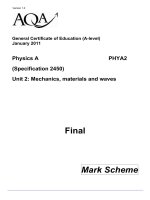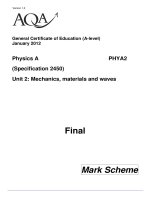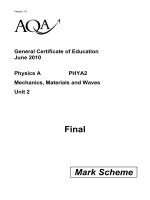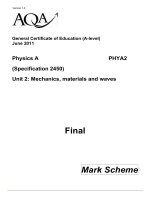AQA ANTH1 w MS JUN14
Bạn đang xem bản rút gọn của tài liệu. Xem và tải ngay bản đầy đủ của tài liệu tại đây (140.83 KB, 16 trang )
A-LEVEL
ANTHROPOLOGY
ANTH1/Unit 1 Being Human: Unity and Diversity
Mark scheme
1111
June 2014
Version: 1.0 Final
Mark schemes are prepared by the Lead Assessment Writer and considered, together with the
relevant questions, by a panel of subject teachers. This mark scheme includes any amendments
made at the standardisation events which all associates participate in and is the scheme which was
used by them in this examination. The standardisation process ensures that the mark scheme covers
the students’ responses to questions and that every associate understands and applies it in the same
correct way. As preparation for standardisation each associate analyses a number of students’
scripts: alternative answers not already covered by the mark scheme are discussed and legislated for.
If, after the standardisation process, associates encounter unusual answers which have not been
raised they are required to refer these to the Lead Assessment Writer.
It must be stressed that a mark scheme is a working document, in many cases further developed and
expanded on the basis of students’ reactions to a particular paper. Assumptions about future mark
schemes on the basis of one year’s document should be avoided; whilst the guiding principles of
assessment remain constant, details will change, depending on the content of a particular
examination paper.
Further copies of this Mark Scheme are available from aqa.org.uk
Copyright © 2014AQA and its licensors. All rights reserved.
AQA retains the copyright on all its publications. However, registered schools/colleges for AQA are permitted to copy material from this
booklet for their own internal use, with the following important exception: AQA cannot give permission to schools/colleges to photocopy any
material that is acknowledged to a third party even for internal use within the centre.
MARK SCHEME – A-LEVEL ANTHROPOLOGY – ANTH1 – JUNE 2014
QUALITY OF WRITTEN COMMUNICATION
Where students are required to produce extended written material in English, the scheme of
assessment must make specific reference to the assessment of the quality of written
communication. Students must be required to:
•
•
•
ensure text is legible, and spelling, grammar and punctuation are accurate, so that meaning is
clear
select and use a form and style of writing appropriate to purpose and complex subject matter
organise relevant information clearly and coherently, using specialist vocabulary when
appropriate.
The assessment criteria for quality of written communication apply to the assessment of the
20 mark questions. The following criteria should be applied in conjunction with the mark scheme.
The quality of written communication bands must be regarded as integral to the appropriate mark
scheme band even though they are listed separately in the mark scheme. Examiners should note
that, in the assessment of students’ anthropological knowledge and skills, the assessment of the
Quality of Written Communication will be judged through the assessment of the clarity and
appropriateness of the anthropological material presented.
For 10 mark questions:
In the 1 – 3 band, students’ answers are likely to be characterised by the poor logical expression
of ideas and the use of a limited range of conceptual terms, perhaps often used imprecisely and/or
inaccurately. Spelling, punctuation and grammar may show serious deficiencies and frequent
errors, perhaps impairing the intelligibility of significant parts of the answer.
In the 4 – 7 band, students’ answers are likely to be characterised by the fair to good logical
expression of ideas and the competent use of a reasonable range of conceptual terms. Spelling,
punctuation and grammar will be of a reasonable standard. Commonly used words and
anthropological terms will generally be spelt correctly. There may be minor errors of punctuation
and grammar, but these will not seriously impair the intelligibility of the answer.
In the 8 – 10 band, students’ answers are likely to be characterised by the very good to excellent
logical expression of ideas and the precise use of a broad range of conceptual terms. Spelling,
punctuation and grammar will be of a very good to excellent standard. Commonly and less
commonly used words and anthropological terms will almost always be spelt correctly.
Punctuation and grammar will be used correctly throughout to facilitate the intelligibility of the
answer.
3 of 16
MARK SCHEME – A-LEVEL ANTHROPOLOGY – ANTH1 – JUNE 2014
For 20 mark questions:
In the 1 – 7 band, students’ answers are likely to be characterised by the poor logical expression
of ideas and the use of a limited range of conceptual terms, perhaps often used imprecisely and/or
inaccurately. Spelling, punctuation and grammar may show serious deficiencies and frequent
errors, perhaps impairing the intelligibility of significant parts of the answer.
In the 8 – 15 band, students’ answers are likely to be characterised by the fair to good logical
expression of ideas and the competent use of a reasonable range of conceptual terms. Spelling,
punctuation and grammar will be of a reasonable standard. Commonly used words and
anthropological terms will generally be spelt correctly. There may be minor errors of punctuation
and grammar, but these will not seriously impair the intelligibility of the answer.
In the 16 – 20 band, students’ answers are likely to be characterised by the very good to excellent
logical expression of ideas and the precise use of a broad range of conceptual terms. Spelling,
punctuation and grammar will be of a very good to excellent standard. Commonly and less
commonly used words and anthropological terms will almost always be spelt correctly.
Punctuation and grammar will be used correctly throughout to facilitate the intelligibility of the
answer.
INDICATIVE CONTENT AND RESEARCH IN THE MARK SCHEMES
Please note that any of the indicative content and research that is presented in the mark bands of
the higher mark questions may be present in any of the mark bands, not solely the higher band.
4 of 16
MARK SCHEME – A-LEVEL ANTHROPOLOGY – ANTH1 – JUNE 2014
0
1
Total: 70 marks
Explain what is meant by ‘biocentric’ and illustrate your explanation with an example
(4 marks)
(Item A, line 7).
Two marks for a satisfactory explanation or definition such as:
•
•
an attitude or ethical stance which believes that humans are no more important
than any other species
the view that nature or natural things have value in and of themselves.
One mark for a partially satisfactory explanation or definition, such as:
•
living in harmony with nature.
Two marks for a satisfactorily explained example such as:
•
•
•
the Dongria’s belief that the mountain they live on is sacred and therefore must
be respected and protected regardless of the cost to themselves
conservationists look upon other species as having value and strive to protect
those species even if they have no benefit to humans, eg campaign to protect
the northern spotted owl in Oregon (Satterfield)
deep ecologists such as Earth First believe that humans have no special status
among species.
One mark for a partially explained example, such as Dongria believing the mountain is
sacred.
0
2
Identify and briefly explain two reasons why humans modify the body, apart from the
reason given in Item B.
(6 marks)
One mark for each of two appropriate reasons identified, such as:
•
•
•
•
express their identity as part of a subculture
conform to the norms and values of society
express religious or political beliefs
gain status within society or social/economic group.
Two marks for each satisfactory explanation, such as:
•
•
•
•
express identity as part of a subculture: piercings and suspension from hooks
(Clifford-Jaeger’s Suspend Your Beliefs)
conform to norms and values of society: dieting to conform to media image
(Becker’s study of Fiji)
express religious or political beliefs: tattoos that represent these beliefs such as
a cross or a swastika
gain status within society or social group: training in a sport or a gym in order to
develop muscles (Wacquant’s study of boxing).
One mark for a partially satisfactory explanation, such as piercings with no explanation
of how piercings express identity as part of a subculture.
5 of 16
MARK SCHEME – A-LEVEL ANTHROPOLOGY – ANTH1 – JUNE 2014
0
3
Examine two or more effects of gift exchange on social relations.
(10 marks)
0
No relevant points.
1-3
Answers in this band will show only limited knowledge and understanding, and
show very limited, if any, interpretation, application, analysis or evaluation.
Lower in the band, there may be one or two insubstantial points about gift
exchange. There will be minimal or no interpretation, application, analysis and
evaluation.
Higher in the band, answers will present one or two insubstantial points about
the effects of gift exchange. There will be very limited interpretation,
application, analysis and evaluation.
4-7
Answers in this band will show reasonable knowledge and understanding, and
show limited interpretation, application, analysis and evaluation.
Lower in the band, material on one effect of gift exchange for social relations
will be presented and some limited description will be offered, for example, that
gift exchange helps cement social ties, though interpretation, application,
analysis and evaluation are likely to be very limited.
Higher in the band, material on two or more effects of gift exchange for social
relations will be presented and some explanation offered, for example an
ethnographic example to show how gift exchange leads to increased social
ties. Reasonable knowledge and understanding will be shown, and
interpretation and application will begin to meet the demands of the question.
Students may begin to offer some analysis and/or evaluation.
8-10
Answers in this band will show sound and detailed knowledge and
understanding of material on two or more effects of gift exchange for social
relations. The material will be accurately and sensitively interpreted and
applied to the demands of the question. Students will show the ability to
organise material and to analyse and/or evaluate it explicitly, so as to produce
a coherent and relevant answer.
Lower in the band, answers may examine a more limited range of material.
Interpretation and application may be less focused, and analysis and/or
evaluation less developed.
Higher in the band, answers will be more detailed and complete with a wider
range of material. Interpretation and application of material will be more
focused and answers will show sensitivity in interpretation of the question.
Analysis and/or evaluation will be more relevant and explicit.
Issues, concepts and theories such as the following may appear:
•
gift exchange increases social ties between individuals and/or social
6 of 16
MARK SCHEME – A-LEVEL ANTHROPOLOGY – ANTH1 – JUNE 2014
•
•
•
•
•
groups eg Kula Ring
gift exchange increases the power or status of a leader or social group,
eg moka, potlatch, kula
gift exchange improves kinship relations eg cattle given as part of
Masai dowry
gift exchange cements marriage and courtship eg Na courtship
concept of ‘the gift’ (Mauss)
reciprocity: generalised, balanced and negative.
Students may show interpretation, application, analysis and evaluation by reference to
issues such as:
•
•
•
•
•
•
•
cross-cultural comparison
analysis and ‘unpacking’ of concepts, eg problems of defining a ‘gift’
awareness of methodological issues, eg etic vs emic understanding of gift
exchange
application of ethnographic examples from a wide range of societies,
including any that might be the result of students’ research
critique of any of the points put forward, in particular the fact that the
concepts themselves are problematic
awareness of the relevant key debates in anthropology:
eg biological vs cultural explanations (the need for gift exchange as a
possible biological imperative which enhances survival or gift exchange as
having no biological benefits); unity vs diversity (highlighting common
aspects of gift exchange in a number of societies or stressing the
differences); agency vs structure (awareness of how a mode of gift
exchange may be imposed on individuals or showing how individuals may
adapt/change the way gifts are given, thus causing the effects to change)
awareness of relevant theoretical perspectives, eg functionalism (gift
exchange maintains and enforces social solidarity); Marxism (gift
exchange enhances the power of certain individuals); feminism (gift
exchange as enhancing the power of males over females); interpretivism
(gift exchange may have different meanings for different groups or
individuals in the same society); postmodernism (the way gift exchange is
changing and losing its connection with particular social structures).
However, not all of these are necessary, even for full marks.
7 of 16
MARK SCHEME – A-LEVEL ANTHROPOLOGY – ANTH1 – JUNE 2014
0
4
Analyse two or more reasons why some social groups use magic.
(10 marks)
0
No relevant points.
1-3
Answers in this band will show only limited knowledge and understanding, and
show very limited, if any, interpretation, application, analysis or evaluation.
Lower in the band, there may be one or two insubstantial points about magic,
but these will be ineffectively used. There will be minimal or no interpretation,
application, analysis and evaluation.
Higher in the band, answers will present one or two insubstantial points about
the use of magic. There will be very limited interpretation, application, analysis
and evaluation.
4-7
Answers in this band will show reasonable knowledge and understanding, and
show limited interpretation, application, analysis and evaluation.
Lower in the band, material on one or more possible reasons why some social
groups use magic will be presented, for example, means to obtain good
fortune, but without any particular examples. Some students may refer to the
use of witchcraft as a way of causing misfortune, though there may be some
lack of focus on witchcraft as a form of magic. Some reasonable knowledge
and understanding will be shown, though interpretation, application, analysis
and evaluation are likely to be limited.
Higher in the band, material on two or more reasons why some social groups
use magic will be presented and some explanation offered, for example
reference to how Trobriand Islanders use magic as a way of ensuring safety on
the fishing expeditions. Witchcraft examples will be explicitly related to
witchcraft as a form of magic, for example, pagan witchcraft rituals or the use of
oracles in detecting witchcraft. Reasonable knowledge and understanding will
be shown, and interpretation and application will begin to meet the demands of
the question. Students may begin to offer some analysis and/or evaluation.
8-10
Answers in this band will show sound and detailed knowledge and
understanding of two or more reasons why some social groups use magic.
The material will be accurately and sensitively interpreted and applied to the
demands of the question. Students will show the ability to organise material
and to analyse and/or evaluate it explicitly, so as to produce a coherent and
relevant answer.
Lower in the band, answers may examine a more limited range of material.
Interpretation and application may be less focused, and analysis and/or
evaluation less developed.
Higher in the band, answers will be more detailed and complete with a wider
range of material. Interpretation and application of material will be more
focused and answers will show sensitivity in interpretation of the question.
Analysis and/or evaluation will be more relevant and explicit.
8 of 16
MARK SCHEME – A-LEVEL ANTHROPOLOGY – ANTH1 – JUNE 2014
Issues, concepts and theories such as the following may appear, such as the use of
magic:
•
•
•
•
•
•
•
•
definition of magic: the conscious, intentional use of supernatural or
psychic powers to achieve an outcome
as a way of controlling the world eg voodoo (MacCarthy)
for finding out information eg oracles among the Azande
as a way of ensuring positive outcomes eg the Trobriand Islanders
(Malinowski)
as symbolic, providing meaning in perplexing situations (Tambiah)
as a way of bringing people together, easing tension and anxiety
(Malinowski, Evans-Pritchard and the Azande)
as a way of establishing hierarchy eg witches’ covens (Greenwood)
to transform consciousness eg wicca.
The following may be included to demonstrate interpretation, application, analysis and
evaluation:
•
•
•
•
•
•
•
cross-cultural comparison, eg contrast between western paganism and
traditional uses of magic
analysis and ‘unpacking’ of concepts, eg different kinds of magic
awareness of methodological issues, eg the problem of understanding
what magic may mean to the participants
application of ethnographic examples from a wide range of societies,
including any that might be the result of students’ research
critique of any of the points put forward, eg critique of the view that people
use magic to get an actual outcome
awareness of the relevant key debates in anthropology:
eg biological vs cultural explanations (the way in which humans have
developed practices that have symbolic rather than practical value);
unity vs diversity (what uses are the same in a variety of cultures);
agency vs structure (the way in which individuals may have a different use
for magic than that prescribed by the society)
awareness of relevant theoretical perspectives: functionalism (magic as
maintaining social cohesion; Marxism (magic as used by dominant elites to
ensure the outcome they want); feminism (magic used by women as a way
of enhancing their power); interpretivism (different meanings for the uses
of magic); postmodernism (the way magic has been used by western
paganism in very different ways from the traditional uses or the way magic
is used alongside science).
However, not all of these are necessary, even for full marks.
9 of 16
MARK SCHEME – A-LEVEL ANTHROPOLOGY – ANTH1 – JUNE 2014
0
5
Examine the ways in which studies of the great apes can help anthropologists to
understand what it means to be human (Item B).
(20 marks)
0
No relevant points.
1-7
Answers in this band will show limited or no knowledge and understanding and
some very limited interpretation, application, analysis or evaluation.
Lower in the band, there may be one or two very insubstantial points with little
understanding of relevant issues.
Higher in the band, answers will show limited, knowledge, for example two or
three insubstantial points about studies of the great apes. Interpretation and
application of material may be simplistic, or at a tangent to the question.
Analysis and/or evaluation will be very limited or non-existent.
8-15
Answers in this band will show reasonable knowledge and understanding and
will show limited interpretation, application, analysis and/or evaluation.
Lower in the band, this may be confined to a competent if basic account of
the ways in which studies of the great apes can help anthropologists
understand what it means to be human, for example comparison of apes and
humans but lack of focus on the uses of studies. Interpretation may be limited
and not applied explicitly to the demands of the question.
Higher in the band, knowledge and understanding of material will be broader
and/or deeper. The answer will begin to examine the ways in which studies of
the great apes can help anthropologists understand what it means to be
human in more depth, for example discussion of studies of social relations
among apes, with explicit reference to what these studies tell us about possible
human behaviour. Material will be accurate, though its relevance may not
always be made explicit. There may be some limited analysis and/or
evaluation. However this is not a requirement to reach the top of this band.
16-20 Answers in this band will show sound and detailed knowledge and
understanding of material on the ways in which studies of the great apes can
help anthropologists understand what it means to be human. This will be
accurately interpreted and applied to the demands of the question. The
student will show the ability to organise material and to analyse and/or
evaluate it explicitly so as to produce a coherent and relevant answer.
Lower in the band, answers may examine a more limited range of material.
Interpretation and application may be less focused, and analysis and/or
evaluation less developed.
Higher in the band, answers will be more detailed and complete with a wider
range of material. Interpretation and application of material will be more
focused and answers will show sensitivity in interpretation of the question.
Analysis and/or evaluation will be more relevant and explicit.
10 of 16
MARK SCHEME – A-LEVEL ANTHROPOLOGY – ANTH1 – JUNE 2014
Issues, concepts and theories such as the following may appear:
•
•
•
•
•
•
•
•
•
•
•
explanation of the relationship between humans and the great apes, eg how
humans have evolved from apes
significance of the comparison between humans and chimps and bonobos, eg
that humans have characteristics of both
specific reference to studies of the great ape (Goodall) which show
characteristics which are similar to humans
social organization: studies of apes show how primates are social creatures
and only survive by co-operating in social groups
relations between the sexes: studies show the complex nature of relations
between the sexes and the role of the alpha male
intelligence and development of the mind: studies of the great apes show the
significance of problem-solving in the development of human beings, eg in the
invention of tools
kinship: studies of the great apes show the importance of family, especially in
the rearing of children
relationship with the environment, eg studies show that apes transform their
environment through the use of basic tools
the body: how humans evolved their body from the ape body structure
beliefs and morality: evidence from studies of the great apes indicate that a
sense of right and wrong is part of living in social groups
reference to specific biological anthropologists (Underdown, Dunbar, Foley,
Ridley).
In answering the question, the following may be included to demonstrate
interpretation, application, analysis and evaluation:
•
•
•
•
•
•
•
•
•
an argued position, stressing the importance of studies of the great apes to the
understanding of what it means to be human, eg the fact that humans are
closely related to the great apes and therefore there may be some genetic
factors that affect our behaviour
an argued position, stressing the limitations of such studies, eg culture has
become much more important in defining what it means to be human
reference to Item B, relations between male and females
cross-species comparison, eg reasons why the studies can be used, such as
the close genetic link or reasons why the studies cannot be used, such as the
fact that we have cultural evolution and are now so different from our cousins
analysis and ‘unpacking’ of concepts, eg issues surrounding definitions of
‘culture’
awareness of methodological issues, eg problems of making connections
between studies of primates and humans
application of a range of primate studies to different ethnographic examples
from a wide range of societies, including any that might be the result of
students’ research
critique of any of the points made
awareness of the relevant key debates in anthropology:
eg biological vs cultural explanations (discussion of whether biological
11 of 16
MARK SCHEME – A-LEVEL ANTHROPOLOGY – ANTH1 – JUNE 2014
•
explanations are still relevant, therefore arguing that studies of primates have
little relevance); unity vs diversity (finding commonality between apes and
humans or finding differences within apes and/or humans); agency vs structure
awareness of relevant theoretical perspectives: functionalism (using evidence
from primate studies to support a functionalist perspective eg Dunbar’s findings
on the important role of the family and kinship among primates); Marxism
(using evidence from primate studies to support a Marxist perspective);
feminism (using evidence from primate studies to support a feminist
perspective eg. the key role of the alpha male in chimp social relations as
opposed to the more equalitarian relations between the sexes in bonobo
groups, showing that male dominance is not inevitable); interpretivism;
postmodernism
However, not all of these are necessary, even for full marks.
12 of 16
MARK SCHEME – A-LEVEL ANTHROPOLOGY – ANTH1 – JUNE 2014
0
6
‘Relations between humans are based mainly on competition and inequality’.
Using material from Item A and elsewhere, assess this view.
(20 marks)
0
No relevant points.
1-7
Answers in this band will show only limited interpretation, application, analysis
or evaluation, and will show only limited knowledge and understanding.
Lower in the band, there may be one or two very insubstantial points or
material ineffectually recycled from Item A, with little understanding of relevant
issues.
Higher in the band, answers will show limited, undeveloped, generalised
knowledge, for example with two or three insubstantial points about relations
between humans being unequal. Interpretation of material may be simplistic or
at a tangent to the question.
8-15
Answers in this band will show some reasonable interpretation, application,
analysis and/or evaluation and will show some reasonable knowledge and
understanding.
Lower in the band, some potentially relevant material will be presented and a
broadly accurate if basic account offered of whether human relations are
mainly based on on competition and inequality, for example a simplistic
account of how social groups need inequality in order to function, with no
ethnographic example. Interpretation and application to the demands of the
question may remain implicit.
Higher in the band, knowledge and understanding of material will be broader
and/or deeper, for example discussion of relations between humans being
mainly based on competition and inequality, in the context of a specific
ethnographic example, and may make limited use of the Item. Material will be
accurately interpreted but its relevance may not always be made explicit.
There will be some limited explicit analysis and/or evaluation.
16-20 In this band, analysis and evaluation will be explicit and relevant, and answers
will show sound and detailed knowledge and understanding of anthropological
material on whether or not relations between humans are mainly based on
competition and inequality, drawn from Item A and elsewhere. This will be
accurately interpreted and applied to the demands of the question. Students
will show the ability to organise the material and to analyse and/or evaluate it
explicitly, so as to produce a coherent and relevant answer.
Lower in the band, answers may examine a more limited range of material.
Interpretation and application may be less focused, and analysis and/or
evaluation less developed. Answers will show some organisation but the
conclusion may be less developed or partially supported by the body of the
essay.
Higher in the band, answers will be more detailed and complete with a wider
range of material. Interpretation and application of material will be more
focused and answers will show sensitivity in interpretation of the question.
13 of 16
MARK SCHEME – A-LEVEL ANTHROPOLOGY – ANTH1 – JUNE 2014
Analysis and/or evaluation will be more relevant and explicit. Answers will
show a clear rationale in the organisation of material leading to a distinct
conclusion.
Issues, concepts and theories such as the following may appear:
•
•
•
•
•
•
•
•
•
•
reference to competition and inequality in terms of resources, and/or
gender or age
awareness of the potential biological origins of competition and inequality,
such as studies of chimps show that males fight to be the alpha male
awareness of the potential biological origins of co-operation and equality ,
such as studies of bonobos
theoretical views, including Marx and Engels, Rousseau and Hobbes
ethnographic studies to show competition, eg studies of gangs (Ward,
Bourgois), studies of Amazonian tribes (Chagnon)
ethnographic studies to show co-operation rather than competition, eg the
San/Kung!, Hadza of Tanzania and the Mbuti of the Congo (Lee,
Woodburn, Turnbull)
ethnographic studies to show that gender inequality is a key part of social
relations (Ortner), or not (Lepowsky)
ethnographic studies to show that competition may be the result of outside
influences on a culture rather than an inherent part of that culture, eg Brian
Ferguson’s reply to Chagnon arguing that warfare in the Yanomani was the
result of contact with westerners
view that all contracts, such as the gift, have their origin in communism,
understood as an unconditional commitment to fulfilling another’s need
(Mauss)
anthropology of anarchism (Graeber).
In answering the question, the following may be included to demonstrate
interpretation, application, analysis and evaluation:
•
•
•
•
•
•
•
•
•
reference to Item A
any position on the spectrum: arguing that relations between humans are
mainly based on competition and inequality to arguing that they are mainly
based on co-operation and equality
cross-cultural comparison
cross-species comparison
analysis and ‘unpacking’ of concepts, eg the meaning of equality
awareness of methodological issues, eg the problem of interpretation of
the meaning of practices so that it is hard to identify if there is competition
or inequality
application of ethnographic examples from a wide range of societies,
including any that might be the result of students’ research
critique of any of the points made
awareness of the relevant key debates in anthropology:
eg biological vs cultural explanations (discussion of whether competition
and inequality have biological origins); unity vs diversity (the extent to
which all societies have competition and inequality); agency vs structure
(the extent to which some individuals may choose to have different ideas
and practices compared to the rest of their society )
14 of 16
MARK SCHEME – A-LEVEL ANTHROPOLOGY – ANTH1 – JUNE 2014
•
awareness of relevant theoretical perspectives: functionalism (competition
and inequality as functional or dysfunctional); Marxism (competition and
inequality as a result of unequal property ownership); feminism
(competition and inequality as stemming from male domination);
interpretivism; postmodernism.
However, not all of these are necessary, not even for full marks.
15 of 16
MARK SCHEME – A-LEVEL ANTHROPOLOGY – ANTH1 – JUNE 2014
ASSESSMENT GRIDS FOR A-LEVEL ANTHROPOLOGY UNIT 1 (ANTH1)
Examination Series: June 2014
ASSESSMENT OBJECTIVES
Questions
AO1
AO2
Total
0
1
2
2
4
0
2
2
4
6
0
3
6
4
10
0
4
5
5
10
0
5
12
8
20
0
6
8
12
20
Total
35
35
70
Converting Marks into UMS marks
Convert raw marks into Uniform Mark Scale (UMS) marks by using the link below.
UMS conversion calculator www.aqa.org.uk/umsconversion
16 of 16









